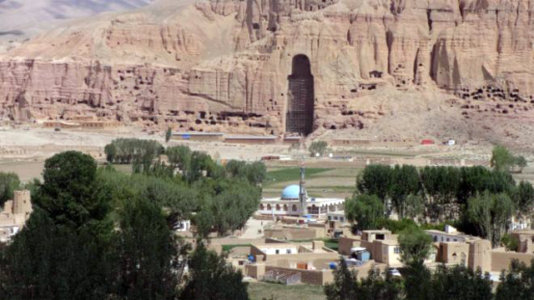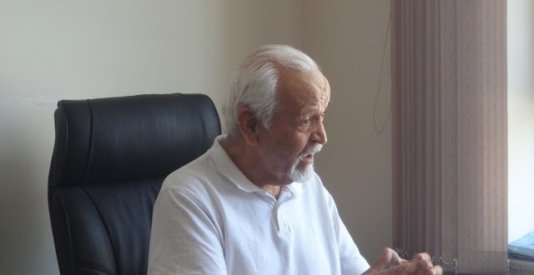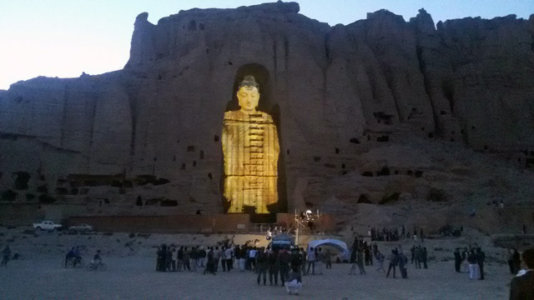- About
- Topics
- Picks
- Audio
- Story
- In-Depth
- Opinion
- News
- Donate
-
Signup for our newsletterOur Editors' Best Picks.Send
Read, Debate: Engage.
| June 16, 2015 | |
|---|---|
| topic: | Peace and Reconciliation |
| tags: | #Afghanistan, #archeology, #Bamiyan province, #Buddha, #China, #monk, #Sarwar Danish, #South Asian Association for Regional Cooperation (SAARC), #Sulaiman Layeq, #Taliban regime |
| located: | Afghanistan, China |
| by: | Shadi Khan Saif |
As they say: Time is a great healer. On Friday (05 June), the central Bamiyan province of Afghanistan - the place where the militants blew-up two 6th Century monumental statues of a standing Buddha - was celebrated as the Cultural Capital of South Asia.
The South Asian Association for Regional Cooperation (SAARC) bestowed this honor upon Bamiyan for the year 2015.
Lying on the ancient Silk Road (the revolutionary trade route that tied together China, India, the Middle East and the Mediterranean) some 260 kilometers west of capital Kabul, the area was the site of several Buddhist monasteries and a thriving center for religion, philosophy and art for ages.
Monks at the monasteries lived as hermits in small caves carved into the side of the Bamiyan cliffs. Though most of the population in this region embraced Islam 9th Century onwards, they also embraced their past and many were appalled by the destruction of Buddha’s statue.
Afghan officials have expressed profound hope that the SAARC declaration would provide an opportunity for Bamiyan to generate considerable cultural, social and economic benefits.
Vice President Sarwar Danish and the Minister for Culture and information Abdul Bari Jahani alongside representatives of the SAARC members gathered in the historical city on Friday to launch the two-day festivity. The Kabul government planned art exhibitions, seminars, musical shows and poetic evenings, screening of films and documentaries for the occasion, something unimaginable during the Taliban rule.
It also included tours to the United Nations Educational, Scientific and Cultural Organization (UNESCO) protected sites of cultural landscape and archaeological remains of the Bamiyan Valley.
The Vice President thanked regional countries for acknowledging the historical worth of the area. Danish vowed the government under President Mohammad Ashraf Ghani was committed to reforms, eliminating extremism and bring positive changes in the lives of Afghans. In particular, he took the opportunity to assure the lives and liberty of the people would not be sacrificed for peace talks with the rebels.
Afghan officials touched upon the emerging threat of the ISIS in Afghanistan and the need to protect country’s archaeological treasure during their speeches.
In the eyes of the celebrated poet Sulaiman Layeq, Afghans, with their love for humanity and peace, would remain more than thankful to the regional countries for respecting the country’s history and providing an opportunity to celebrate and revive it.
“Throughout its history Afghanistan has been at the very centre of various religious ideologies and civilizations”, Layeq said while referring to the ancient history of Buddhism, the birth of Zoroastrianism and the spread of Islam from here into the region.
Bamiyan is not the only place holding evidence of the war-torn country’s rich past. At around 75 kilometers southeast of Kabul, the province of Logar too sits on an ancient Buddhist city. In here, the ancient city “Mes Aynak” or "little copper well" was once at the heart of the bustling Silk Road.
Buddhists from all over Asia made pilgrimages to worship at Mes Aynak, and for thousands of years, it flourished as one of the most important cities in the region. As its importance waned through the centuries, it was slowly abandoned and eventually, this once mighty city was forgotten, its history lost to the sands of time.
Since 2009 archeologists have unearthed dozens of unique and never-before-seen stupas and temples, enormous monastic complexes, vivid murals, thousands of precious artifacts, and around 600 Buddha statues - similar in style to those destroyed by the Taliban in 2001 at Bamiyan.
Archaeologists have also found evidence of an older Bronze Age site beneath the Buddhist city, meaning there is at least 5,000 years of civilization at Mes Aynak.
As Afghanistan braces for a new era of self-reliance following the departure of foreign forces and shrinking aid, the local leadership finds itself caught between some difficult choices.
Eight years ago, the government awarded lucrative copper mining contract at Mes Aynak to the Chinese state-owned firm China Metallurgical Group Corporation that plans to open-pit mine here. Activists argue that this means blowing up Mes Aynak and reducing it - and an entire mountain range - to rubble.
Thousands of Afghans and people from various other countries have waged the #SaveMesAynak since then to prevent the Chinese firm from doing further damage.
In the case of Bamiyan however, it is quite the opposite. The people there hope a massive iron ore mine Hajigak would change the fortune of the area as it poses no threat to the protected heritage.
Meanwhile, a ray of hope has been provided to the #SaveMesAynak campaign by the country’s new Minister for Mines and Petroleum. Dawood Shah Sabasaid on Wednesday (03 June) that exploring big mines would do no good to the country as the ministry lacked the professional skills and knowledge to properly monitor the large scale mining.
He criticized the Chinese firm for not considering the environmental and social effects of the project in their assessment.
In this regard, commenting about the future of archeological sites in Afghanistan the Sulaiman Layeq said Afghans are poor but they know the worth of history. The veteran artist closes: “As Zoroaster (founder of Zoroastrianism) once said life is a battle between the light and the darkness, so is the case in Afghanistan and we hope forces of the light would prevail in protecting the symbols of peace and humanity”.
By copying the embed code below, you agree to adhere to our republishing guidelines.




